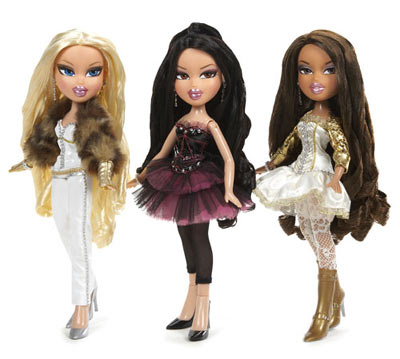|
 Bratz doll is a line of sultry-eyed, mini-skirted fashion dolls |
|
Preteen girls who dress in sexualized clothing are judged as less competent and less moral than kids in age-appropriate garb, new research finds. Earlier studies have found that adult women who dress in revealing clothing are seen as less competent than women who are more buttoned-up. One study published in the Journal of Personality and Social Psychology in November even found that scantily clad men suffer similar judgment. Clothing for young girls has become increasing sexualized, said Sarah Murnen, a social psychologist at Kenyon College in Ohio and the senior author of the new study. Last year, a study by Murnen and colleagues found that 30 percent of children's clothing at major retailers had sexualizing characteristics. The researchers recruited 162 students, 106 of them women, to view photographs of a prepubescent blonde white girl wearing one of three different outfits and rate them on traits such as competence and intelligence. In the "childlike" condition, the girl wore a gray shirt with ruffled sleeves, jeans and Mary Jane-style shoes. In the "ambiguously sexualized" condition, the girl wore a modest-length dress with a leopard-print pattern — a pattern that is often associated with sexy clothes, but is not overtly sexual. In the final condition, the girl wore an obviously sexualized outfit: a very short dress with a leopard-print cardigan and purse. In some photos, the girl was described as an average fifth-grader who enjoys reading and is a member of the student council. In others, she was described as being a top reader at the top of her class and president of the student council. Describing the girl as a higher achiever did prompt people to rate her as more intelligent and capable, as you might expect, Murnen said. But across the board, people's rankings of the girl's capability, competence, determination and intelligence dropped when she wore the obviously sexualizing outfit. They also ranked her as having lower self-respect and less morality than more modestly dressed versions. In fact, when the researchers asked participants for feedback after the experiment, many were quite aware of their judgments. "I formed my assumptions based on her outfit even after being aware of her accomplishments," one woman wrote. "Seems like a caricature of a Bratz doll," wrote another man, referring to a line of sultry-eyed, mini-skirted fashion dolls. "Overall first impression isn't strong." (Read by Emily Cheng. Emily Cheng is a journalist at the China Daily Website.) (Agencies) |
新研究发现,那些穿性感衣服的十三岁以下的小女孩被认为在能力和品德上都不如那些穿适合自己年龄衣服的小孩。 早先的研究就已发现,人们认为穿着暴露的成年女性不如那些衣着保守的女性有能力。一项发表在《个性与社会心理学杂志》11月刊上的研究甚至还发现,穿着暴露的男性也遭到同样的成见。 研究报告的高级作者、美国俄亥俄州肯尼恩学院的社会心理学家莎拉•穆尔嫩说,给小女孩穿的衣服变得越来越性感。去年,穆尔嫩和其同事开展的一项研究发现,大型零售店卖的儿童服装有30%含性感元素。 研究人员招募了162名学生(其中有106名是女性)来观看一个金发白皮肤的青春期前小女孩穿三套不同衣服的照片,并让他们给小女孩的能力和智力等品质打分。在“适合孩子”的情况下,小女孩穿的是袖口打褶的灰色衬衫、牛仔裤和绑带鞋。在“隐约性感”的情况下,小女孩穿的是一条豹纹的及膝裙,豹纹花案经常出现在性感衣服中,但这一衣着并没有过分性感。 在最后一种情况下,小女孩穿的是一件显然十分性感的衣服:一条超短裙搭配一件豹纹开襟绒线衫和手提包。 在一些照片中,小女孩被描述成一个喜欢读书的普通的五年级小学生和学生会成员。在其他照片中,她被描述成班里读书最好的拔尖学生和学生会主席。 穆尔嫩说,正如你所预料的,把小女孩描述成一个成绩出色的人确实促使人们对她的智力和能力给出更高的评价。然而,当小女孩穿过分性感的服装时,人们对她的才华、能力、决断力和智力的评价却一致下降了,对自尊和品行的评价也低于她衣着朴素时的评价。 事实上,当研究人员在实验后向参与者寻求反馈时,许多人对自己的判断都有清楚的意识。 一名女性写道:“即使在意识到她的成就后,我还是依据她的穿着来做出设想。” 另一名男性写道:“就好像布拉茨娃娃的夸张版”,他指的是一组眼神撩人、穿超短裙的时装娃娃。“总的来说第一印象并不好。” 相关阅读 (中国日报网英语点津 陈丹妮 编辑:Julie) |
|
Vocabulary: preteen: 十三岁以下的孩子 garb: (某种职业或民族特有的)服装,装束 revealing: 暴露身体的,袒胸露肩的 buttoned-up: 不外露的 prepubescent: 青春期前的 Mary Jane-style shoes: 玛丽珍鞋,对绑带鞋的美式统称,尤指那些低跟、圆面、脚踝搭扣绑带式的鞋子。 across the board: 全面的,一致的 caricature: 夸张(或滑稽的)模仿 Bratz doll: 布拉茨娃娃,这种娃娃一改芭比娃娃端庄、高贵的完美造型,用不同肤色、不同种族的娃娃配以高底皮靴、热裤背心等前卫装扮打造出一个个流行时尚的活力女孩。 sultry: (女子等)撩人的;淫荡的 |
